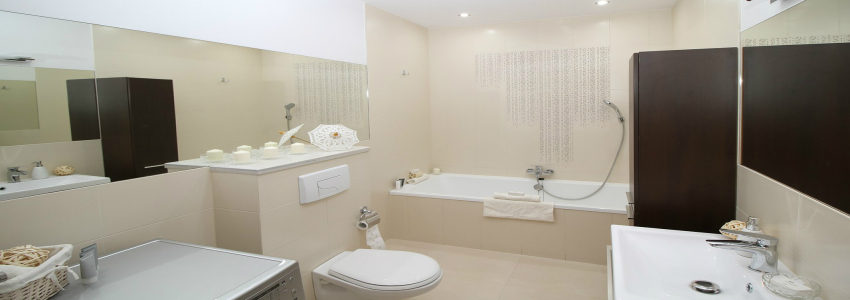If you decide to add a bathroom to your basement, this can not only increase the comfort in your home, but it also adds value to your property. If you decided to do a basement remodel and turn into a guest bedroom, a game room or even an exercise room, a bathroom allows you to enjoy the space without having to run upstairs each time you need to use the bathroom.
However, even if it’s a smart idea, adding a bathroom to your basement is something you shouldn’t take lightly. There are certain issues that make projects involving belowground plumbing more complicated than those made in the rest of the house. So, you should consider certain aspects and discuss them with your contractor.
Consider the design
The best solution is to locate the bathroom as close as possible to the existing electrical wiring and plumbing as possible. Placing the basement bathroom right below the one on the floor above is the best option. This way, connecting the new bathroom to the existing utilities is easier and less expensive.
The next step is to decide which type of bathroom you want. Do you want a full bathroom, complete with a shower cabin or a bathtub? Or do you prefer a half – bath with only a sink and a toilet? As basements tend to already be damp and chilly, you might want to consider skipping the bathtub or the shower and opt for a practical half – bath instead.
If you do want to have the possibility of taking a shower, you could opt for a corner shower, because it’s more economical. Especially where there is also a shower, a proper ventilation system is a necessity to draw out any moisture.
Even further, if you also want to add a laundry area next to the basement bathroom, keep in mind that you will need a floor drain to manage any overflows and have access to an exterior wall for the dryer vent.
Drainage issues
Drainage is one of the most critical aspects when it comes to adding a bathroom to a basement space. Aboveground plumbing uses gravity to drain away wastewater and sewage. In the case of a basement bathroom, there must be enough of a fall, like in the case of gravity, to drain the toilet, the shower or the bathtub. Therefore, plumbing depth and pipe size are very important and it may be necessary to install new pipes in the basement.
In some cases, you may need a backwater valve, which prevents the sewage from backing up into your toilet. In addition, if the drainage lines are not deep enough, you may need to remove part of the basement floor and do some excavating work. Therefore, a basement bathroom can become a very complex remodeling project and more expensive than you originally anticipated.
Options for the basement toilet
Depending on the existing plumbing, you have several options to choose from for a basement toilet.
Pressure- assisted toilets are a god idea, because they use air pressure to force waste through the pipes. That way, you will considerably reduce the risk of clogging.
Up flushing toilets are easy to install, especially because it’s not necessary to remove any concrete or any part of the basement floor to make room for one. The plumbing lines run up through the wall and connect to the sewer or to a septic tank line. Some of these toilets also have a macerating function, which grinds down waste to further prevent clogging. Newer models rely on electricity instead of water pressure, like in the case of older toilet, so that issues regarding overflow or odor are avoided.
Composting toilets are an eco-friendly alternative for basement bathrooms. They use little or no water and basically turn waste into compost. However, the main disadvantage is that they are designed only for toilet waste, not for wastewater and require a very good outside ventilation system.
Installing a bathtub/shower in a basement bathroom
Installing either a bathtub or a shower in a basement bathroom raises the same issues as the ones concerning toilets. It may be necessary to remove part of the floor and do some excavation to install the necessary plumbing.
If plumbing stubs are available, it’s possible to install a bathtub or a shower just like in any other room. If not, the shower or the bathtub can connect to an up flush toilet or to a sewage-ejector system (which can also be used for toilets).
Lighting fixtures
God lighting in a bathroom is essential to ensure your comfort. Basement bathrooms are by default darker. Some basements already have windows, but if you don’t have any on the wall where you want to place the bathroom consider adding some, because natural light is the best way to brighten up a space. Glass-block windows are an easy and simple alternative to allow daylight in the bathroom without losing your privacy. In addition, bright ceiling lights and light installed in the sink area ensure proper lighting.
By adding a bathroom to a basement already turned into a functional space gives it that extra touch that makes it look just like any other room in your home. Choosing the best layout, preventing any plumbing issues and adding some nice decorative elements can make a basement bathroom as luxurious as any other type of bathroom.
When it comes to remodeling, the Good Deal Remodeling team considers that customer satisfaction comes first and we make sure that you’re 100% happy with your bathroom remodeling or with your basement remodel. Don’t hesitate to contact us for more details.

